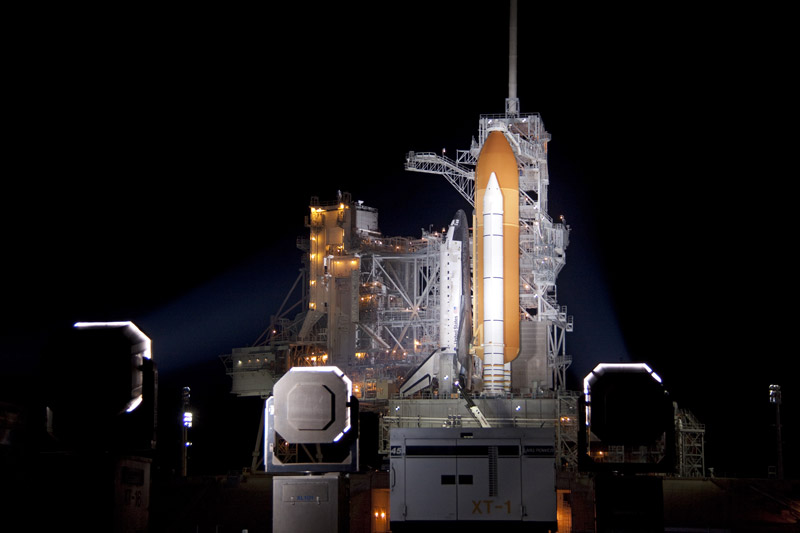Third Crack Found in Metal Skin of Shuttle Discovery's Fuel Tank

NASA engineers have discovered a third small crack in thealuminum skin of the huge external fuel tank for space shuttle Discovery while tacklingrepair work ahead of the spacecraft's final spaceflight.
Engineers at the Kennedy Space Center in Florida werealready studying two 9-inch (23-centimeter) cracks discovered on the shuttle's15-story fuel tank earlier this week.
Those previously known cracks are in a so-called metal"stringer" ? or ring around an upper section of the tank, and beneatha layer of damaged foam insulation. The latest crack, discovered today, is onthe metal skin on an adjacent section of the fuel tank. [GRAPHIC:NASA's Space Shuttle ? From Top to Bottom]
"The thinking is, when the original stringer crackedbecause of stress and pressure loads, it then transferred, and the adjacentstringer on the left hand side got a small crack in it," NASA spokesmanAllard Beutel told SPACE.com. ?
Discovery's next flight is its last mission before thespacecraft is retired along with the rest of NASA's shuttle fleet. The missionhas been delayed since Nov. 1 due to technical glitches, weather, a potentiallyhydrogen gas leak, and the foam and metal cracks in the fuel tank. The gas leakand cracks were discovered during a Nov. 5 launch attempt.
The shuttle's fuel tank "stringers" are aluminumstrips that provide structural integrity to a part of the fuel tank known asthe intertank ? the partition between the liquid oxygen and liquid hydrogentanks.
Beutel described the new crack as being about 3 inches (7.6 cm)long on the left-hand side of the original cracked section.
Get the Space.com Newsletter
Breaking space news, the latest updates on rocket launches, skywatching events and more!
Shuttle technicians will analyze data over the weekend todetermine the best possible repair method that can be performed with Discoveryremaining at the launch pad.
"They're going to analyze the new data and expand theirlook for additional cracks," Beutel said. "They want to betterunderstand how much stress that area can take, and how the cracks happen in thefirst place."
Shuttle technicians have repaired similar cracks on externaltanks by removing the fractured aluminum and replacing it with a twice-as-thickstringer section, before replacing the foam. But these repairs have neverbefore been executed at the launch pad.
Previously, these types of cracks were addressed during theexternal tank production phase at NASA's Michoud Assembly Facility in NewOrleans, where spaceshuttle fuel tanks are built.
Today, engineers also began replacing a component called theground umbilical carrier plate (GUCP) on Discovery's external tank that servesas an attachment point between the tank and a 17-inch (43-cm) pipe that carriesgaseous hydrogen safely away from the shuttle.
A misalignedseal within the GUCP was to blame for a hydrogen gas leak that stalledDiscovery's latest launch attempt on Nov. 5.
NASA technicians will continue to analyze data and monitormeasurements from the GUCP over the weekend to ensure a proper alignment of theseal. Teams hope to proceed with the GUCP installation and repair next week.?
NASA is hoping to complete the work and try once again tolaunch what will be spaceshuttle Discovery's final flight on Nov. 30.
The space agency is retiring its three-shuttle fleet nextyear and Discovery's upcoming delivery trip to the International Space Stationwill be its final trip into orbit.
- Gallery: Building Space Shuttle Discovery
- Video ? Space Shuttle Discovery: A Retrospective, Part 2, Part 3
- Space Shuttle Discovery's Retirement Plan in Limbo
Join our Space Forums to keep talking space on the latest missions, night sky and more! And if you have a news tip, correction or comment, let us know at: community@space.com.

Denise Chow is a former Space.com staff writer who then worked as assistant managing editor at Live Science before moving to NBC News as a science reporter, where she focuses on general science and climate change. She spent two years with Space.com, writing about rocket launches and covering NASA's final three space shuttle missions, before joining the Live Science team in 2013. A Canadian transplant, Denise has a bachelor's degree from the University of Toronto, and a master's degree in journalism from New York University. At NBC News, Denise covers general science and climate change.









